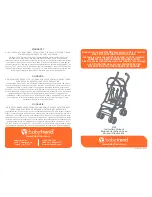
User manual iSMA-B-AAC20/M-Bus Network
Version 1.2
www.globalcontrol5.com
Page 5 / 13
Figure 2 M-Bus connection topology
A two-wire cable (jYStY N*2*0.8 mm) is used as the transmission medium for the M-Bus.
The maximum distance between the slave and the repeater is 350 m; this length
corresponds to a cable resistance of up to 29
Ω
. This distance applies for the standard
configuration having a baud rate between 300 and 9600 baud rate, and a maximum of 250
slaves. The maximum distance can be increased by limiting the baud rate and using fewer
slaves, but the bus voltage in the Space state must at no point in a segment fall below 12 V,
because of the remote powering of the slaves. In the standard configuration, the total cable
length should not exceed 1000 m, in order to meet the requirement of a maximum cable
capacitance of 180 nF.
3.2 M-Bus Addressing
The M-Bus devices are using two types of addressing:
•
Primary: This address is assigned by the user in a commissioning process (all new M-
Bus devices have this address, set by the factory to 0); this type of address has a
limited range from 0 to 250;
•
Secondary: This address has a wider range than primary and by default contains a
device serial number. All out of box devices connected to the bus have unique
secondary addresses.
4 M-Bus Kit Components
The M-Bus kit contains two types of device components based on communication interface:
•
Local Device: for devices connected directly to the iSMA-B-AAC20-M (this connection
requires a special hardware version equipment with the M-Bus interface). This type of
communication is using two components:
•
MbusLocalNetwork: The main component responsible for handling local interface,
•
MbusLocalDevice: The component responsible for handling devices connected to
the local interface;































